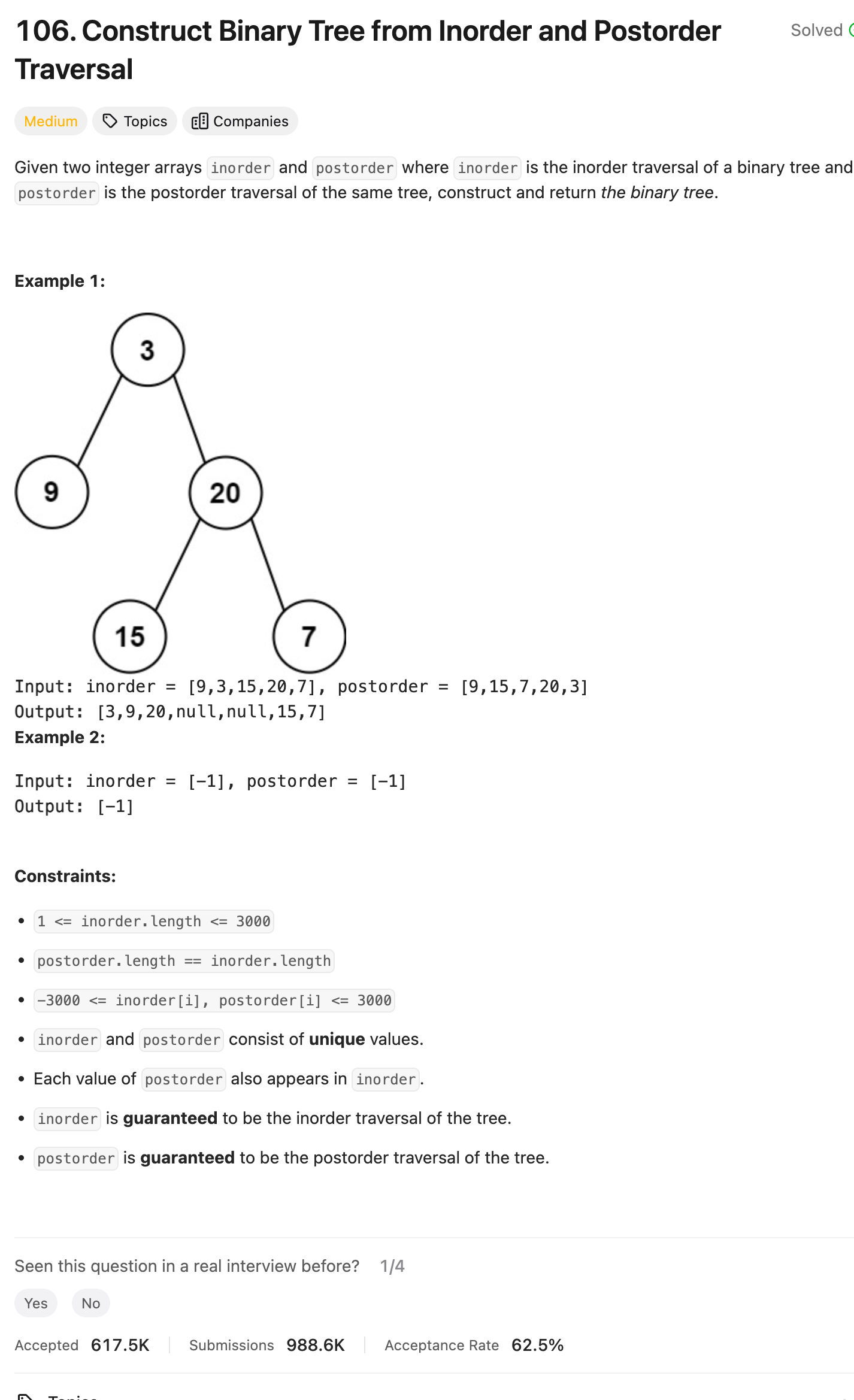Problem of The Day: Construct Binary Tree from Inorder and Postorder Traversal
Problem Statement
Intuition
I’ll be constructing a binary tree using the given inorder and postorder traversals. The postorder traversal provides the root of the tree, and the inorder traversal helps determine the left and right subtrees. By recursively dividing the inorder list based on the root from postorder, I can build the entire binary tree.
Approach
I’ll reverse the postorder list to make it easier to pop the elements from the end. Then, I’ll define a recursive helper function, build, which takes a sublist of the inorder traversal. In each recursive call, I’ll pop the last element from the reversed postorder list, find its index in the current sublist of inorder, and use that to split the inorder list into left and right subtrees. I’ll repeat this process until the entire tree is constructed.
Complexity
-
Time complexity: O(n) where n is the number of nodes in the tree. Each node is processed once.
-
Space complexity: O(n) as the recursive call stack can go up to the height of the tree, and in the worst case, the tree can be skewed.
Code
# Definition for a binary tree node.
# class TreeNode:
# def __init__(self, val=0, left=None, right=None):
# self.val = val
# self.left = left
# self.right = right
class Solution:
def buildTree(self, inorder: List[int], postorder: List[int]) -> Optional[TreeNode]:
N = len(inorder)
postorder.reverse()
def build(arr):
if build.index >= N or not arr:
return
val = postorder[build.index]
i = arr.index(val)
root = TreeNode(val)
build.index += 1
root.right = build(arr[i+1:])
root.left = build(arr[:i])
return root
build.index = 0
return build(inorder)
Other Implementation
Using hash map and two pointers approach
# Definition for a binary tree node.
# class TreeNode:
# def __init__(self, val=0, left=None, right=None):
# self.val = val
# self.left = left
# self.right = right
class Solution:
def buildTree(self, inorder: List[int], postorder: List[int]) -> Optional[TreeNode]:
N = len(inorder)
inorder_index_map = defaultdict()
for i, v in enumerate(inorder):
inorder_index_map[v] = i
def build(l, r):
nonlocal postorder_index
if l > r:
return
val = postorder[postorder_index]
root = TreeNode(val)
postorder_index -= 1
root.right = build(inorder_index_map[val] + 1, r)
root.left = build(l, inorder_index_map[val] - 1)
return root
postorder_index = N - 1
return build(0, N - 1)
Editorial Solution
class Solution:
def buildTree(self, inorder: List[int], postorder: List[int]) -> TreeNode:
def helper(in_left, in_right):
# if there are no elements to construct subtrees
if in_left > in_right:
return None
# pick up the last element as a root
val = postorder.pop()
root = TreeNode(val)
# root splits inorder list
# into left and right subtrees
index = idx_map[val]
# build the right subtree
root.right = helper(index + 1, in_right)
# build the left subtree
root.left = helper(in_left, index - 1)
return root
# build a hashmap value -> its index
idx_map = {val:idx for idx, val in enumerate(inorder)}
return helper(0, len(inorder) - 1)
